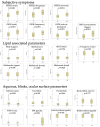Characterization of Individuals with High-Frequency Artificial Tear Supplement Use
- PMID: 40283524
- PMCID: PMC12027582
- DOI: 10.3390/jcm14082694
Characterization of Individuals with High-Frequency Artificial Tear Supplement Use
Abstract
Objectives: We aimed to investigate dry eye parameters as potential predisposing factors and estimate the prevalence of high-frequency topical eye drop usage. Methods: A total of 5594 dry eye patients treated between November 2015 and June 2022 were included. High users (n = 180) were those who applied at least one artificial tear drop per hour, whereas those who used artificial tears fewer than four times daily were classified as low users (n = 5414). Differences in self-reported symptoms (OSDI, SPEED questionnaires) and tear-related parameters, including severity of corneal staining (SPK), fluorescein tear-film break-up time (FTBUT), lipid layer thickness (LLT), number of expressible meibomian glands (MGE), meiboscale, and blink patterns, were assessed. Subsequent follow-up comprehensive dry eye assessments were performed at 3 months. Results: There was no difference in age or sex between high users and low users (p = 0.075 and 0.508, respectively). High users had significantly higher symptom scores (p < 0.001), more total blinks (p = 0.001), lower Schirmer scores (p < 0.001), higher SPK grades (p < 0.001), shorter FTBUT (p = 0.010), and higher limbal redness scores (p = 0.002). However, there were no differences in the LLT, MGE, or meiboscale. The compliance with follow-up examinations at 3 months was significantly greater for the high users (p < 0.001). Patients with OSDI scores > 40, SPEED scores > 12, Schirmer scores ≤ 3 mm, and higher compliance with follow-up examinations had odds ratios of 4.0, 3.3, 1.7, and 4.1, respectively, for being high users (95% confidence intervals = 2.8-5.8, 2.4-4.7, 1.2-2.3 and 2.7-5.2, respectively). Among the high users, reducing topical drops significantly decreased the SPEED and OSDI scores, except for the environmental trigger factor in the OSDI questionnaire. During long-term follow-up, 1.1% of low users and 15.4% of high users received cyclosporine treatment (odds ratio 16.4, p < 0.001). Conclusions: OSDI scores > 40, SPEED scores > 12, and Schirmer scores ≤ 3 mm were associated with high-frequency eye drop usage, which accounted for 3.2% of moderate to severe dry eye patients. Susceptibility to environmental triggers could represent hyperalgesia/allodynia in high users. High users have a higher need for cyclosporine treatment.
Keywords: OSDI; SPEED; Schirmer score; dry eye disease; high-frequency eye drop usage.
Conflict of interest statement
The authors declare no conflicts of interest.
Figures






References
-
- Tsubota K., Yokoi N., Watanabe H., Dogru M., Kojima T., Yamada M., Kinoshita S., Kim H.M., Tchah H.W., Hyon J.Y., et al. A New Perspective on Dry Eye Classification: Proposal by the Asia Dry Eye Society. Eye Contact Lens. 2020;46((Suppl. S1)):S2–S13. doi: 10.1097/ICL.0000000000000643. - DOI - PMC - PubMed
Grants and funding
LinkOut - more resources
Full Text Sources

